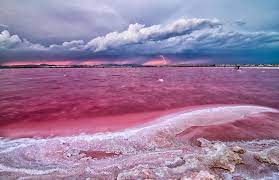The Burgundy-blood Phenomenon is caused by burgundy-blood algae. This species of algae was originally classified as Oscillatoria rubescens, but in 2002 it was re-assigned to the genus Planktothrix and was renamed to Planktothrix rubescens.
The name 'Burgundy-blood' has a somewhat mythical origin: It is attributed to the blood of the Burgundians slain in the Battle of Morat (1476), where a Swiss army delivered a crushing defeat on the Burgundians near Lake Morat (or the Murtensee in German). Supposedly, the lake coloured red from the blood of the slain Burgundian soldiers whose bodies were thrown in the lake.
Burgundy blood algae are a type of filamentous cyanobacteria or 'blue-green algae'. The are ruddy because of their red pigment phycoerythrin. They are accessory to the main chlorophyll pigments responsible for photosynthesis.
Planktothrix grows in long unbranched cell threads, that are called filaments or trichomes. The straight filaments have limited mobility and show phototaxis, the ability to move directionally in response to a light source.
Flowering can occur under favourable conditions. During flowering this species produces a type of microcystin to protect itself. After mass reproduction, the toxin microcystin can pose a threat to aquatic organisms, to the drinking water supply, and to the environment at large.
In cold, Alpine lakes there have always been always blooms of this species that give the water a reddish hue. These Burgundy-blood algae lives in planktonic form in fresh water, especially in deep and stratified cold water lakes. These bacteria were also found in the deeper layers of Alpine lakes, and an occasional ascent was observed. The species can layer itself through gas bubbles (vesicles) within the water column[1].
Increased pollution supplies additional nutrients to these Alpine lakes, causing the Burgundy-blood Phenomenon to occur more frequently and in thicker layers, killing vast amounts of marine live.
Biologists even speculate that Burgundy-blood Phenomenon might even have been the driving cause of the first plague that is described in the Bible as 'the water turning into blood'. Toxic algae forced the frogs out of water. As frogs died mosquitoes, flies and various other insects flourished without existence of their predators. This led to the fifth and sixth plagues where the livestock was diseased. With the increase in insects there was rise of various epidemics, such as malaria. This, in turn, caused a large number of people falling ill.
[1] Walsby et al: The Burgundy-blood phenomenon: a model of buoyancy change explains autumnal waterblooms by Planktothrix rubescens in Lake Zürich in New Phytologist – 2005. See here.


Geen opmerkingen:
Een reactie posten